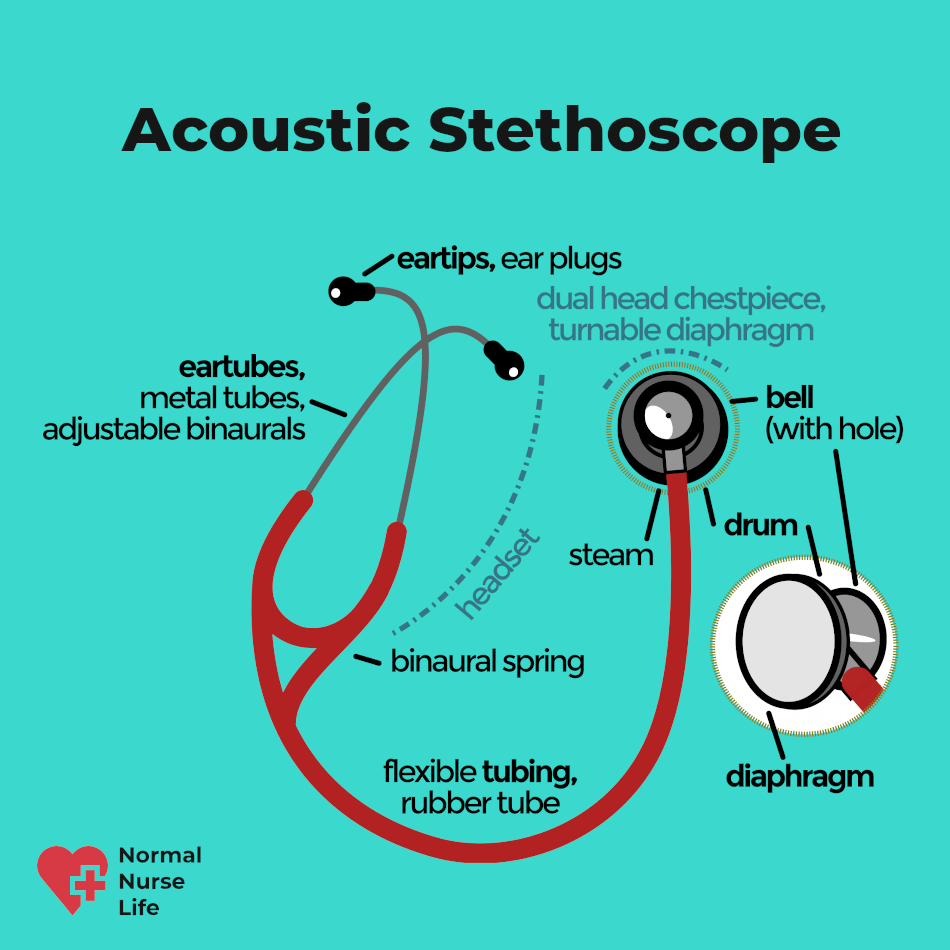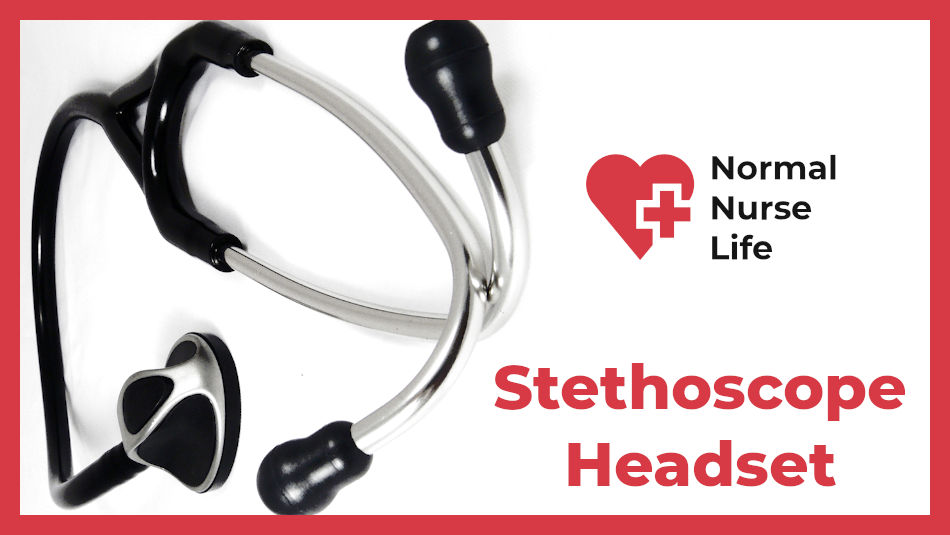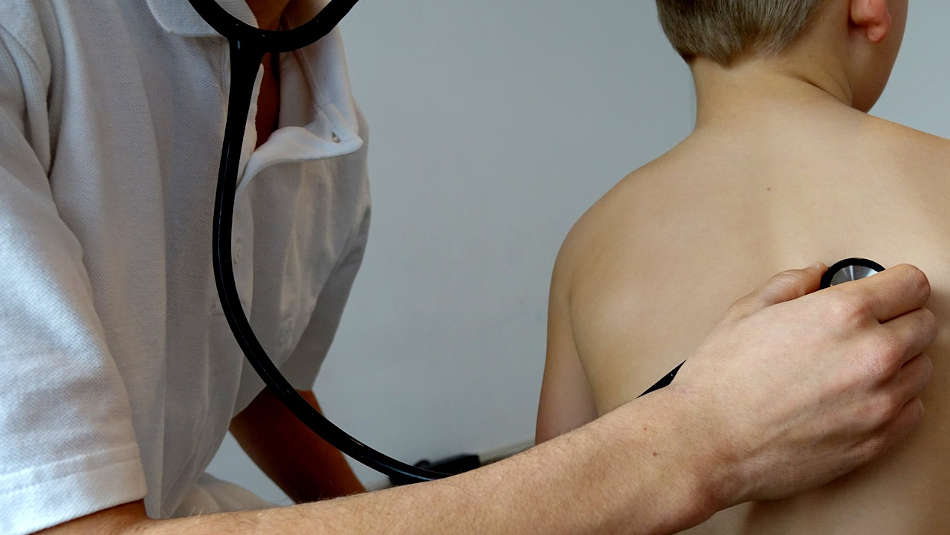In this thorough article, you’ll get to know what is a stethoscope and what is a stethoscope used for. Besides that, you’ll find out what is a stethoscope made of and what can a stethoscope diagnose.
WHAT IS A STETHOSCOPE?
A stethoscope is an acoustic or electronic device used in medical research for listening to internal sounds of the body. The user (registered nurse, neonatal nurse, or a physician for example) places the headphones of the stethoscope on ears and presses the listening area into the patient’s body area to hear the sounds of the area being listened to.
This activity is called auscultation.
Here is a picture of an acoustic stethoscope. In the picture, you can see the ear tips, eartubes, flexible tubing, and of course the diaphragm.

Now that you know the basic information about stethoscope you might think that what is it used for. You guessed it right, that’s coming up next.
Table of Contents
What is a stethoscope used for?
Okay, so what is a stethoscope used for as a medical device. You already know that it is used for listening to the internal sounds of a human body. But what kind of sounds?
A stethoscope is mostly used for listening to the sounds of a human heart. Other than listening to the sounds of a human heart, you can listen to the lung, stomach, and other sounds of humans via a stethoscope.
See also: Do Nurses Use Stethoscopes?
If you are study nursing to become a registered nurse, neonatal nurse or respiratory therapist you should know the five areas for listening to a human heart:
- Aortic: located at the right of the sternal border in the second intercostal space (Base). Sound: S2 “dub”.
- Pulmonic: located at the left of the sternal border in the second intercostal space (Base). Sound: S2 “dub”.
- Erb’s Point: located at the left of the sternal border in the second intercostal space (Base). Sound: S1 and S2 (line of separation between base and apex).
- Tricuspid: located at the right of the sternal border in the fourth intercostal space (Apex). Sound: S1 “lub”.
- Mitral: midclavicular located on the left side of the chest in the fifth intercostal space (Apex). Sound: S1 “lub”.
Basically stethoscope is used for listening to the internal sounds of a human body.
What is a stethoscope made of?

You can see from the picture above, that the stethoscope has six different pieces. Next up I’m going to give you a more detailed description of what is that specific piece made of and what it is used for.
The chestpiece
Also known as the head, the chestpiece is the part of the stethoscope responsible for conducting the sound. The user places this part of the stethoscope to the patient’s skin.
Skin is the best surface to listen to the internal sounds of the human body but some advanced stethoscopes are able to catch sounds even through the clothing and fabrics.
Depending on the stethoscope’s model it can have a one-sided or two-sided chestpiece. Some of the stethoscope models have tunable or pressure-sensitive diaphragms that can act as both a bell and a diaphragm.
On the other hand, there are some stethoscopes with one-sided chestpieces that only have diaphragms.
But what is a stethoscope chestpiece made of? Typically in most cases, the chestpieces are made of metal.
Nowadays at the market, there are also stethoscopes with chestpieces made of acrylic. Acrylic material is great for blocking out ambient noises.
The stethoscope’s chestpiece is made up of the diaphragm and/or bell and the stem. Next up I’m going to give you more details about the diaphragms.
Diaphragm

The circular end of the chestpiece is called the diaphragm. The diaphragm is the larger of the two ends on two-sided chestpieces like in the picture above.
The larger size allows the user of the stethoscope to listen to a larger area of the human patient’s body.
Compared to the bell part the diaphragm is designed to pick up sounds with higher frequencies.
Diaphragms are also designed to eliminate chill against the patient’s skin. Besides that, to have better hypoallergenic properties, increasing the patient’s comfort and safety during the examination.
Bell
Okay, but how about the bell part of the stethoscope?
It’s another circular end of the chestpiece of the stethoscope. The bell is the smaller end on two-sided chestpieces also seen in the picture above.
Because the circular diameter is smaller, it has a more restricted range that focuses more on the lower frequency sounds than the diaphragm.
Did you know that the smaller bell part has also other privileges compared to the diaphragm?
It can be used easier for pediatric and skinnier patients on examinations. Besides that, the bell can catch the sounds better through bandaged areas than the diaphragm.
Stem
In the picture above you can see the part that connects the chestpiece to the stethoscope tubing; that’s called the stem.
Typically in most cases, the stem is made of metal or steel.
It’s also the part that allows the user of the stethoscope to choose between the diaphragm and the bell on two-sided chestpieces. The user of the stethoscope can easily rotate the chestpiece and then click it into the place with a ball bearing.
That determines whether the diaphragm or bell directs the sound to the eartubes.
Tubing
Stethoscope needs tubing to transfer and relay the frequencies or sounds caught up by the chestpiece to the eartubes. Without tubing, the user of the stethoscope could not hear the sounds.
There are two kinds of stethoscopes available:
- Stethoscopes with a single tube
- Stethoscopes with dual lumen tube design
The tubing is split in half on the inside of the dual lumen tubing creating two sound channels inside one outer tube. It separates to left and right paths so that the sounds can reach the stethoscope user’s ears with the best accuracy.
To make the tubing longer-lasting and able to endure constant use and cleaning, it’s designed to withstand skils oils and alcohol.
Most of the time the tubing is made of rubber and plastic.
Headset

The headset part of the stethoscope includes two eartubes, tension springs, and eartips.
What is a stethoscope eartubes made of? Most of the time the eartubes are made of steel or metal.
Eartubes are designed to be at the optimal angle for the best fit into the user’s ear canals. The eartubes isolate and direct the sounds into the left and right paths to provide the user with a better and more accurate listening experience.
The eartubes have ribbed ens where the eartips are then placed.
The part of the stethoscope that actually goes into the ear is called the eartips. Okay, but what is a stethoscope eartips made of then?
The eartips are most of the time made of silicone or rubber.
The eartips have a hole in the middle for letting out the sound straight to the user’s ear.
Now that you know what is a stethoscope made of, it’s time to dig in a little deeper.
Can a stethoscope detect lung problems?
That’s a question that many patients and students study nursing are often looking for the right answer. Here comes the correct answer to the question “Can a stethoscope detect lung problems?“.
Yes, via a stethoscope it’s possible to detect lung problems.
The user of a stethoscope can hear absent or decreased sounds which can mean some of the following:
- Air or fluid in or around the lungs which means that the patient can have pneumonia, heart failure, or pleural effusion.
- Over-inflation of a part of the lungs can be caused by emphysema.
- Increased thickness of the chest wall.
Okay then, what kind of sounds can be heard via a stethoscope?
- High-pitched sounds produced by narrowed airways which are called wheezing.
- The wheeze-like sound heard when the patient breathes that is called stridor.
- Small clicking and bubbling sound in the lungs that is called rales.
- Sounds that resemble snoring that is called rhonchi.
So basically a stethoscope can detect many different kinds of lung problems.
Besides lung problems, what can a stethoscope diagnose then? That’s coming up next.
What can a stethoscope diagnose?

As I stated earlier in this article, you can listen to the sounds of a heart, lungs, and stomach via a stethoscope.
That means that the user of a stethoscope can diagnose many different kinds of problems found in the human body’s abnormal sound. For example, the following illnesses can be diagnosed via a stethoscope:
- Heart failure
- Pneumonia
- Emphysema
- Asthma
- High blood pressure
- Sadly, even death
At this point, you should have a clear vision of what is a stethoscope.
If you want to learn some more about the nursing supplies or nursing in general check out these articles of ours:
- What is a Hoyer Lift?
- What is a Laryngoscopy? Full Definition
- What is a Glidescope? Full Definition
- Is Nursing for Me?
- Do Nurses Get Drug Tested?
- How to Become a Registered Nurse
- Healthcare in Finland
- Nursing in Finland
I’d really appreciate if you would have time to give this article a star rating. It only takes two seconds. Thank you in advance!
